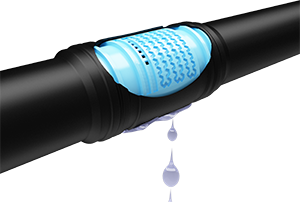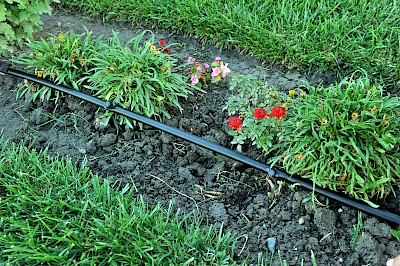- Polypropylene PPR Pipes
- Fiber Glass Three-Layer PPRC Fibre Pipes
- Polypropylene Socket Pipes for Internal Sewage
- Drip Irrigation Pipes
- Pipes PE 100
- Welded Fittings for PE 100 Pipes
- PPRC fittings
- Corrugated Pipes
- Single-Layer Corrugated Pipes
- Double-Layer Corrugated Pipes
- Double-Layer Corrugated Polypropylene Pipes
- Fittings for Corrugated Pipes
- Concentric and Eccentric Crossovers
- Spirally Rolled High-Pressure and Low-Pressure Pipes with a large diameter
- Cast Fittings for PE 100 Pipes
- PPH Sewage Fittings

Drip Irrigation Pipes
General information
After cleaning water from sand, clay, alga etc. with help of special filters it is directly supplied in drops to the root part of plants through drip irrigation pipes. It is possible to use drip irrigation pipes in any landscape terrain.
After cleaning water from sand, clay, alga etc. with special filters it is directly supplied in drops to the root part of vegetation through drip irrigation pipes. It is possible to use drip irrigation pipes in any landscape terrain.
The application of this type of systems allows automation of all irrigation systems while leading to the reduction of labour cost. Contrary to surface irrigation method, the drip irrigation increases the efficiency factor higher than 95 %.
Several positive advantages of application of drip irrigation system are described below:
- more areas may be irrigated through drip irrigation systems with less water;
- efficient irrigation may be performed through these irrigation systems without soil erosion;
- through these systems irrigation water may be supplied along with fertilizers;
- maximum equal distribution of water and food elements;
- simultaneous irrigation of big areas in the form of small parts;
- spread of weeds weakens as plantings remain dry and fighting with them become easy;
- since each area is not irrigated there is no need for breaking topsoil and ventilating the soil and providing its circulation;
Since alkalinity (pH) of soils irrigated by other irrigation systems is high in most cases one part of fertilizers applied is captured by soil colloids and is not easily absorbed by vegetation. In drip irrigation systems fertilizers are applied in parts after each or two irrigations. Since fertilizers are applied not only to the entire field but directly to the root part of vegetation they are more effective although few fertilizers are used.

Alkalinity (pH) of soils is reduced by fertilizers such as phosphorus, nitrogen, sulphide that are used in drip irrigation systems. Just for this reason microelements such as iron, copper, zinc etc. are assimilated (due to lowering of pH). These microelements provide doping effect on growth of vegetation.
High pressure is not required in drip irrigation resulting in decrease of operation costs.
Advantages of drip irrigation:
- direct feeding of root;
- working principle with lower pressure;
- supplying water to the vegetation in the temperature range of optimum 18-28 degrees;
- night irrigation;
- water saving;
- fighting with weeds and parasites;
- minimizing labour force;
- effective usage of fertilizers;
- system automation and increase of performance up to 70 %;
Drip irrigation is used for irrigation of all types of fruit trees (apple, pear, cherry, apricot, medlar, nut, hazelnut, tea plant, citrus trees etc.). It provides only root feeding of the trees.
Drip irrigation is also widely used in irrigation of annual, perennial plants and garden plants melons. In this case, pipes may be placed underground and on the top of ground depending on the type of plant.
The pipes are installed on soil surface or in 0,5 m height above soil surface.
Parameters of pipes manufactured in STP Polymeric Products Plant:
¼ | Pipe dimensions (DxS, mm) | Length of drip element, (mm) | Drip flow rate, (litre/hour) | Interval between drip elements, (mm) |
1. 2. 3. 4. 5. | 12x0.9 16x1.1 16x1.1 20x1.2 20x1.2 | 36 36 40 40 40 | 1.5 2.0 4.0 2.0 4.0 | 190-210 285-315 475-525 710-790 950-1050 |




